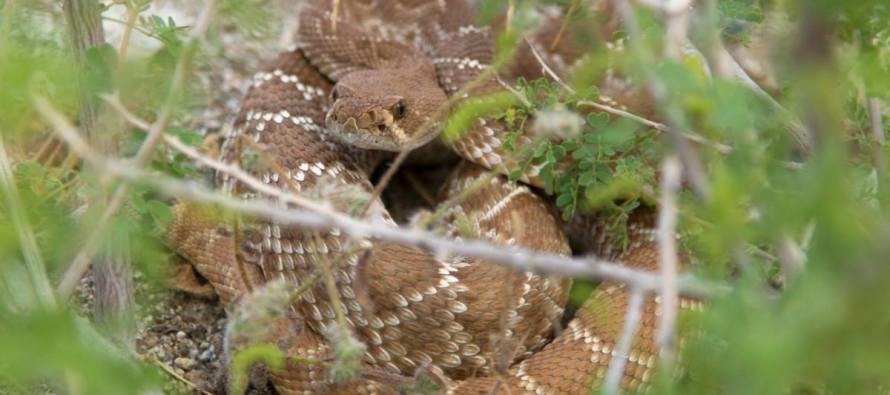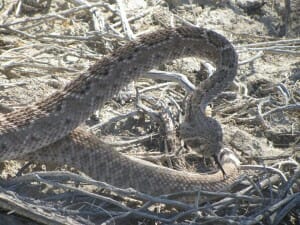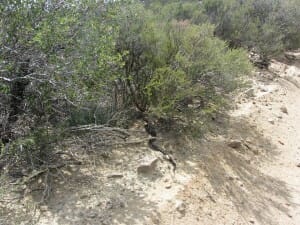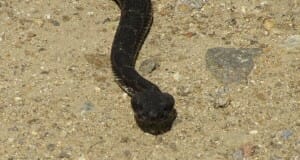What to do if bitten by a snake.

- If you live in the Coachella Valley you should learn how to handle a snake bite.
Each year, about 8,000 venomous snake bites occur in the US and about 5 of those people die.
- You’ve got a good chance of survival if you seek medical attention immediately however that isn’t always easy to do. We have some of the most beautiful hiking trails and some can take you to very remote locations making medical attention take a little longer than we would like when faced with a snake bite.
The Coachella Valley is home to 7 species of the venomous snakes and although rattlesnakes aren’t usually aggressive unless they feel threatened or deliberately provoked it is always better to know what to do than hope you don’t get bitten!
COACHELLA VALLEY’S TOP STORIES

Snake by Geoffrey McGinnis CoachellaValley.com wants to make sure you know what to do should you ever be bitten by a snake in a remote location.
• No first aid is much better than performing bad first aid. Don’t cut at or around the site of the bite, don’t compress the bitten limb with a cord or tight bandage, don’t attempting to extract or neutralize venom using electricity, fire, permanganate, salt, black stones, mouths, mud, leaves, etc.
• All Snake Bite Kits are dangerous and should not be used. This was also confirmed by the Snake Bite Poison Line.
• A lot of snake bite patients injure themselves by panicking directly after a snake bite, by tripping over a rock or tree trunk, or by falling off the side of the trail. Staying calm is important! After a snake bite, walk about 20-30 feet away from the snake.
• Find a safe place to sit down asap. The venom can rapidly diffuse into your system, this can drop your blood pressure too low to pump all the way to your head while standing. Sitting down reduces your chance of fainting within the first few minutes. If you faint, it shouldn’t be more than a few minutes.
• Remove any rings, watches, tight clothing and anything else from the bitten limb, because the swelling will make it a lot bigger soon.
• Take 5 minutes to calm down and plan your evacuation. The only effective treatment for a snake envenomation is the right anti-venom to neutralize it.
• Do not wait for symptoms to appear if bitten. It’s important to get in touch with emergency personnel as soon as possible to get you to a hospital. If you have a cell phone and service, great, call 911 or the Park Ranger. If there is no service, think about the last time you had phone service.
• A sharpie can be a great help for emergency personnel to assess the severity of your snakebite. Circle the location of your snake bite and write down the time next to it. Draw a circle around the border of the swelling and write down the time. Write down all the things you’re experiencing that are not normal, with the time next to it. Examples are: metallic taste in your mouth, changes to sense of smell, sudden loss of vision, double vision, visual disturbances, ringing in the ears, headache, nausea and vomiting, bleeding from anywhere, dizziness, shortness of breath, etc. The most common signs and symptoms are pain and swelling.
• Update this info every 15 or 30 minutes as the swelling moves up the limb and your symptoms develop.
• Make contact via cell phone. If this is not possible, walk slowly to get help. Drink some water and take some calories if you have any. Some snake bite victims walk several miles after serious snake bites to their legs. They make it out fine because they made it out to medical care. This is much better than waiting for help if you can’t reach anyone. Don’t let the fear of “raising your heart rate and increasing the speed of venom circulation” prevent you from moving to get to care. Be very cautious about driving yourself to a hospital, since some bites have serious side effects that could suddenly limit your ability to drive.
Preventing a snake bite is obviously better than dealing with a snake bite. Here are a few ways to reduce the risks of snake bites while trail running:
• Be aware that there could be snakes where you’re running.
• Watch where you’re placing your feet, be extra aware on rocky, sunny areas, pockets of leaves and logs across the trail. If you’re off trail, the odds go up because there are more rocks and cracks and less people to scare the snakes away. Watch out when running through tall grass and weeds.
• Step on a rock or log, not over it. This way you can spot a snake that may be sheltering under it and take action quickly.
• Watch out when sitting down on a rock or tree stump, you might be sitting on a snake.
• Don’t try to chase the snake off the trail, this is why most people get bit by snakes.
• Don’t run with headphones on trails, or have at least 1 ear-bud out.
• Snakes tend to be near water, especially if it’s in a dry environment. If you’re near a spring or river, keep an extra eye out.
• Since snakes are cold-blooded, they’d like to come out when it’s warm and sun themselves on rocky areas or trails. They like to be on the edge of a sunny patch. If you come across a sunny patch, your encounter chances increase.
• Most venomous snakes in the US rest during the day. The chances of running into one are higher in the mornings and early evenings, when their activity might be a bit higher.
• In the spring, after snakes have hibernated together, the frequency of sightings goes up. In the fall, when they retreat to a hiding place to spend the cold winter months, they are on the go, so higher chances to encounter a snake. Most snake bites occur between April and October.
The above is a summary of things learned by Flo and after talking to the Snake Bite Poison Line (1-800-222-1222 available 24/7), after doing his own online research and after posting my snake questions on Reddit Running.
The best info came from Jordan Benjamin, a herpetologist specialized in venomous snakes. We are sharing this information because it might help you one day.
Photos by Geoffrey McGinnis
COACHELLA VALLEY’S TOP STORIES
Related Articles
BNP Paribas Open 2020 Features All Top 75 Ranked WTA And ATP Tour Singles Players
BY BNP PARIBAS OPEN Nine Former Champions Including Novak Djokovic, Naomi Osaka, Roger Federer, Bianca Andreescu, Rafael Nadal, Serena
Coachella Valley’s 5th Annual Palm Springs Chalk Festival
Coachella Valley’s 5th Annual Palm Springs Chalk Festival FREE to the public (donations of any amount are of course
Desert X 2019 – February 9 – April 21 throughout the Coachella Valley!
Desert X 2019 will be held February 9th- April 21st throughout the Coachella Valley! This is the exhibition space. Stay tuned….? &





